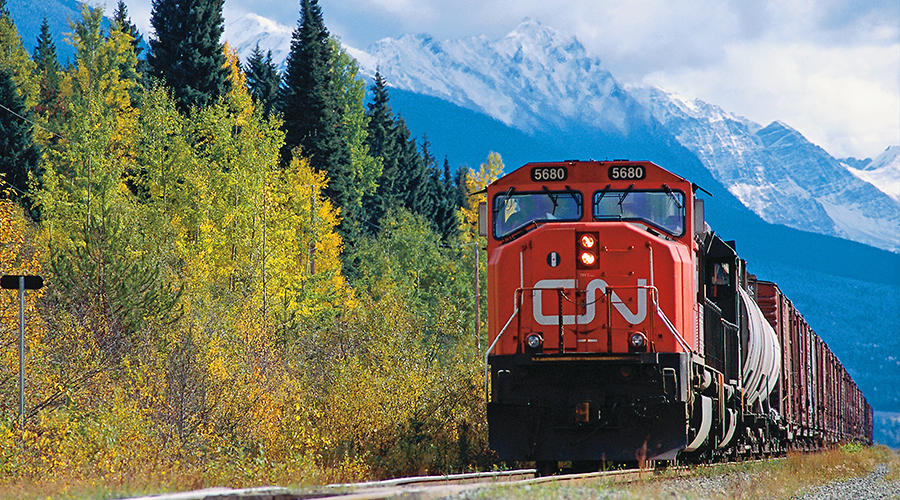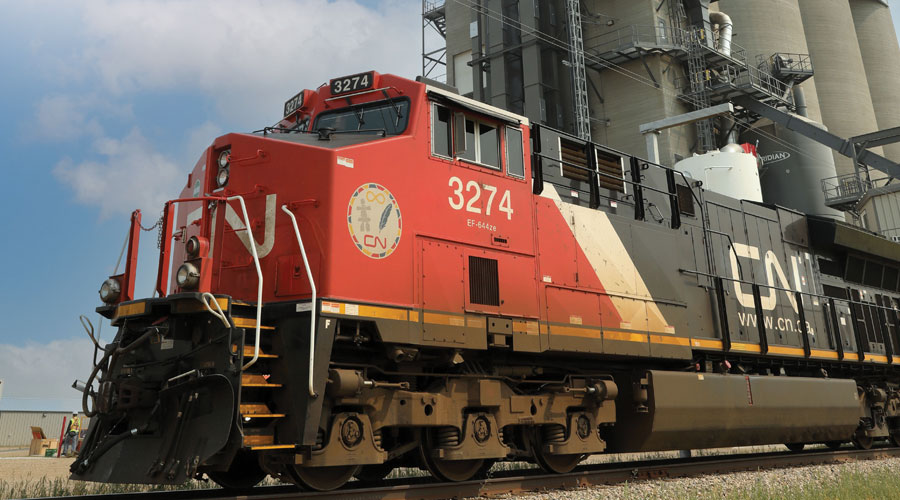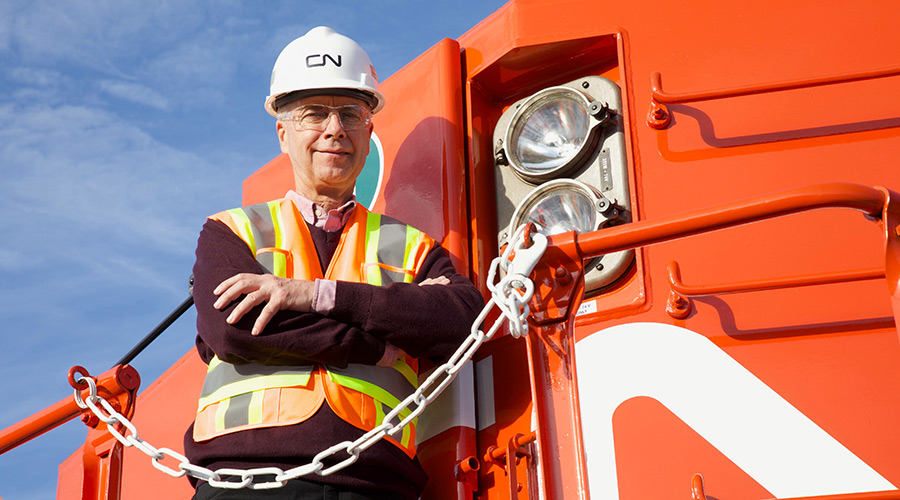Stay updated on news, articles and information for the rail industry
May 2019
Rail News: Canadian National Railway - CN
CN at 100: Innovations, efficiencies to propel the railroad during its next century in business
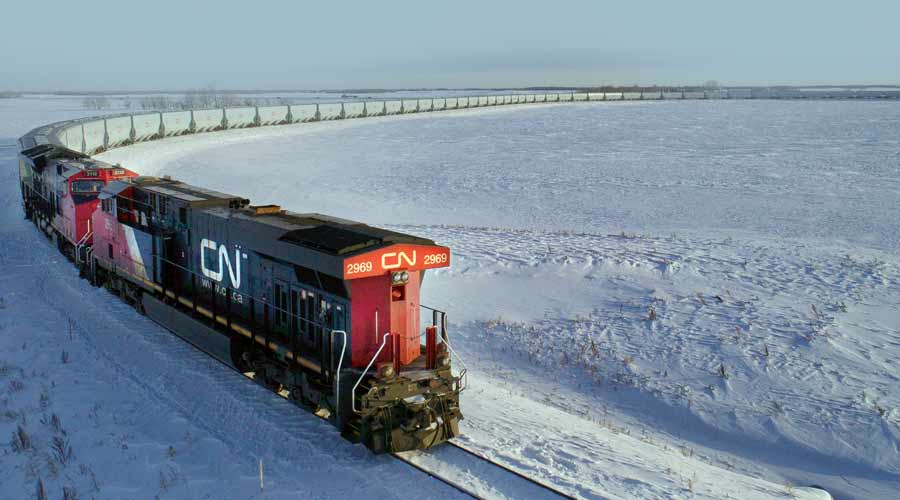
By Jeff Stagl, Managing Editor
On June 6, 1919, an act of Parliament incorporated CN by combining several railroads that were bankrupt or owned and absorbed by the Canadian government.
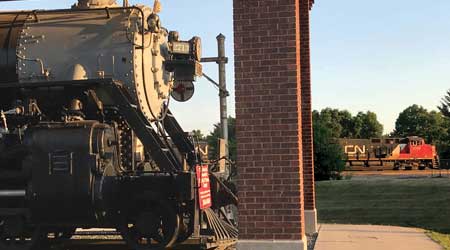
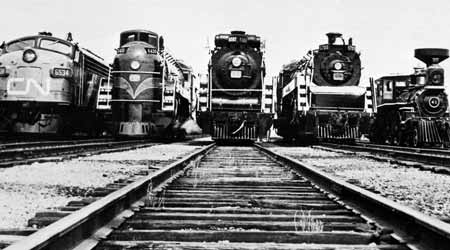
With the 100th anniversary nearing, CN’s leaders are reflecting on what’s transpired since that group of insolvent and disparate railroads were forged into a new crown corporation. The company’s evolution into one of North America’s best-performing railroads both operationally and financially is a compelling story, they believe.
Seminal events over the past century include the:
• addition of Grand Trunk Pacific in 1923 and absorption of Central Vermont Railway in 1927;
• pioneering of two-way train phone service in 1930;
• introduction of continuous-welded rail to Canada in 1954;
• use of the nation’s first hot-box detector in 1961; and
• acquisitions of Illinois Central Corp. in 1999, Wisconsin Central Ltd. in 2001, BC Rail Ltd. in 2004 and key portions of the Elgin, Joliet & Eastern Railway in 2009.
CN has grown into a transportation services provider with about 27,000 employees and a 20,000 route-mile network in Canada and mid-America. On an annual basis, revenue exceeds CA$14 billion, carloads reach 6 million units and the operating ratio typically is near or below 60.
The company has several operating railway subsidiaries, owns assets worth about CA$38 billion, and provides rail, intermodal, trucking, freight forwarding, warehousing and distribution services.
Association of American Railroads President and Chief Executive Officer Ian Jefferies congratulated CN on what he characterizes as “100 incredible years.” The railroad has served a wide range of customers with integrity and continues to play a role in making the industry smarter, safer and more efficient, Jeffries said in an email.
“The industry continues to evolve and CN is a leader in bringing the freight-rail industry into the new era of modern transportation,” he said.
To commemorate the centenary anniversary and mark the railroad’s rich past — specifically, the key historical moments, contributors and technological changes — the Class I plans to conduct a special tour over the next 16 months in several major Canadian and U.S. cities.
Each of the 14 stops on the “CN100: A Moving Celebration” tour will feature music, food and themed rail containers. Exhibits and workshops will be offered to inform employees, retirees, residents and others about the railroad’s history.
Since connectivity to many communities has long been vital to CN, the tour will stress how the railroad has aided and will continue to benefit dozens of cities and towns.
But CN’s progression since 1919 isn’t at the forefront of senior executives’ minds. They’re much more fixated on the Class I’s present and future. While acknowledging the past, they’re trying to assert their attention on the railroad’s short- and long-term strategies, which target top-line growth, cost control, higher productivity, better service performance and more innovations.
To learn more about those objectives — as well as how past events helped mold CN — Progressive Railroading emailed a series of questions to CN President and CEO Jean-Jacques Ruest, Executive Vice President of Corporate Services and Chief Legal Officer Sean Finn, and Senior VP and Chief Information and Technology Officer Michael Foster. They provided responses about the railroad’s greatest achievements, biggest challenges, potential hurdles, technology’s current and future role, and some possible highlights to come. [Editor's note: On June 3, Foster will become executive vice president and chief information and technology officer per a recent promotion.]
The defining moment
The 1995 privatization that turned CN into a publicly held corporation with traded stock was perhaps the biggest turning point in the railroad’s history, said Ruest, who joined the Class I in 1996 after working for a major international chemical company for 16 years. It set the railroad on its current course.
“Privatization required us to redefine ourselves into a private company that needed to compete with other privately run railroads,” Ruest said.
Acquisitions have been defining factors, as well. During the past 20 years, the network has grown through a series of them.
The Elgin, Joliet & Eastern Railway acquisition provided a highly competitive route to bypass the rail congestion in and around Chicago, while the addition of BC Rail afforded a deep reach into the resource-rich northern regions of British Columbia, Ruest said.
Meanwhile, the Wisconsin Central acquisition helped CN develop and connect new markets, and provided a better connection between western Canada and the United States.
But perhaps the most important and transformative acquisition was the Illinois Central Railroad, which aligned the Class I with trade moving north and south because of the North American Free Trade Agreement (NAFTA), Ruest said.
“It transformed CN from a Canadian railroad into a truly North American railway and the only one serving all three coasts,” he said.
With markets changing and trade diversifying, the Class I needs to keep growing and expanding, while making its value “felt and understood,” Finn believes.
“A truly North American railroad that ties both the U.S. and Canada together with international markets [is vital],” he said.
Another thing that’s important to CN: maintaining a communal presence systemwide.
“We don’t just operate in towns across North America, our 25,000 employees and 40,000 retirees eat, sleep and live there, too, which is why we are so focused on being a partner and a good neighbor all across our network,” Finn said.
As a company, CN aims to be a supply chain partner and enabler, and not just a mover of trains, he said.
“We help our customers win in their markets and we help communities achieve their goals,” Finn said.
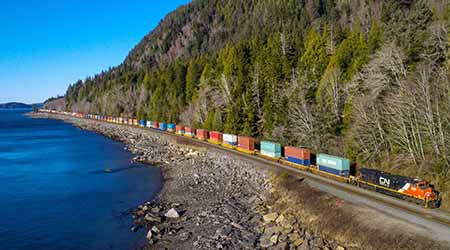
The main challenge — as it is for any company — is how to elicit and embrace change.
“Whether it is increased crop sizes or a shift toward multimodal transport, new commodities that need to be delivered or new technologies, we need to constantly ask ourselves how we can improve,” Finn said. “This is why we are investing approximately 25 percent of our revenues back into our network as capital investments year after year.”
Both organic and inorganic
Organic growth — or growing with the economy and customers — is crucial, Ruest believes. Since 2012, CN has registered an industry leading 3.5 percent compound annual growth rate.
“Our customers tell us we are different from other railroads — we are embedded in their supply chains, we understand their markets, we help them win in their markets and we are ready to deploy our capital to work for our customers,” Ruest said.
To that end, CN is investing an all-time-high CA$3.9 billion in capital expenditures this year. Maintaining capex at record levels will ensure customer demand is met where needed, Ruest said. The Class I is buying 140 locomotives — which will be delivered by year’s end — ordering additional rail cars and hiring more crews.
The railroad is focused on inorganic growth, as well, and there are strategic opportunities to add more supply chain offerings, Ruest said.
The late 2018 acquisition of The TransX Group of Cos. is a perfect example, he said. TransX provides various transportation and logistics services, including intermodal.
Through a subsidiary, CN also recently reached an agreement to acquire H&R Transport Ltd.’s intermodal division.
Moreover, CN in early May announced two new export supply chains targeted at Asia: thermal coal moving from a Hinton, Alberta, mine to Ridley Terminals, and propane moving from Alberta to a new Ridley Island export terminal.
“I’ve often described this strategy as ‘feeding the beast,’” Ruest said. “The focus is on maximizing existing assets through inorganic growth and increasing capacity through targeted investments.”
CN aims to be more aligned with the consumer-driven economy.
“We will keep the focus on innovation and sweating our assets, which has served us so well,” Ruest said.
Innovator extraordinaire
CN long has been an innovator, Ruest added. The Class I is the original large scale implementer of scheduled railroading, which has been in place for more than 15 years. Most Class Is are employing or adopting the operating strategy that now is more commonly called precision scheduled railroading.
Credited as an innovation devised by former CN leader E. Hunter Harrison — who also implemented it at Canadian Pacific and CSX before he died in December 2017 — scheduled railroading calls for shifting the focus from moving trains to moving cars and minimizing car-handling events.
“We invented it and we derived enormous value from it for our loyal customers and our loyal shareholders,” Ruest said. “We [now] have evolved past scheduled railroading to a supply-chain transportation leader.”
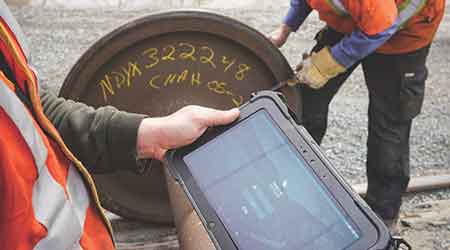
CN also developed or refined many of the technologies in use by the North American rail industry, he said. The Class I invented the beltpack remote-control locomotive device — which prompted yard management flexibility — perfected ultrasonic test cars for rail-flaw detection, and installed the industry’s most trackside wheel-impact detectors and hot-journal detectors.
The Class I also is driving safety in part by employing other trackside and handheld technologies. Train crews are using about 9,000 mobile devices and carmen are using 500 shared handheld devices to report activities wirelessly.
CN is interested in both rail and non-rail-specific technologies to improve reliability and safety, said Foster, the chief technology officer. The railroad employs a dedicated research and development team that evaluates the applicability of technologies such as blockchain, artificial intelligence (AI), data science operationalization, multi-cloud orchestration, intelligent agents and augmented reality.
Collaboration is key
CN also is increasingly working with external partners to stay abreast of the latest technological trends and patterns, and is constantly working with startups, universities and other industry thought-leader platforms to further innovation efforts, Foster said.
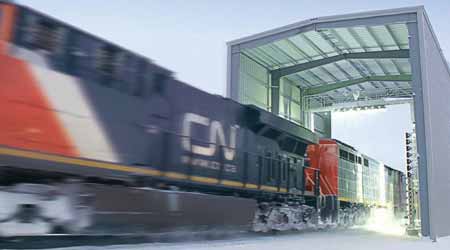
The big driver is to leverage all possible technology solutions and enable customers with applied technologies.
“We are looking at the supply chain from a holistic view and creating platforms that will allow us to be agile, scalable and faster to deploy with reusable cloud-based technology,” Foster said.
To date, CN has adopted various automated inspection technologies, including mobile test cars and inspection portals that provide employees with additional information to safeguard operations.
The innovations use various back-end and edge platforms based on innovative algorithms, lidar and machine-vision capabilities that are scalable and reusable, said Foster.
By 2019’s end, the Class I expects to employ seven train inspection portals in Canada and the United States, as well as five inspection cars. Provided by Duos Technologies Inc., the portals combine several intelligent technologies and subsystems designed to provide real-time images and a host of data for a variety of rail-car inspection criteria.
In addition, the Class I has adopted deep learning modeling for joint bar crack detection. In the back office, robotic processing automation has been a growth area, allowing field employees to focus on value-added instead of repetitive tasks, Foster said.
“Many of these technologies are now connected to our enterprise big data platforms, which are enabling CN to transform from reactive to proactive and predictive decision-making,” he said.
This year and next, CN plans to continue deploying machine, deep and reinforcement learning tools, and other automation to boost AI capabilities.
“What is most exciting is how the company is organizing itself to increase the scalability, reusability and deployment speed of our technology,” Foster said. “To further accelerate technology deployment, we are increasingly migrating to a platform-based architecture that allows us to deploy technology solutions faster and at a lower cost.”
The data dynamic
IT managers also are paying close attention to the scale of the internet of things and the data it generates. A conundrum is becoming a better connected railroad that generates the data needed to drive insights into operating more effectively without getting lost in the data, Foster said.
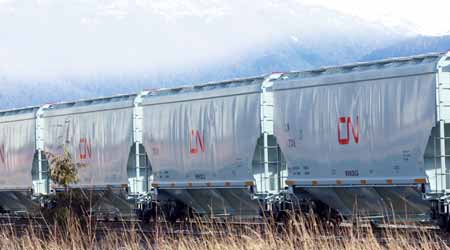
“A challenge for the years ahead will be how to manage the dynamic between the flow of data and our ability to find the truth inside thousands and thousands of data points,” he said. “We are doing this through our platform architecture approach and by leveraging non-rail technology with leading providers in their fields.”
But what, perhaps, is the future in innovation? It could be next-generation automation technology that will continue to reduce the impact of human error and limitations on railroad operations, Foster believes.
The use of IT in managing infrastructure planning and locomotive maintenance, asset management, track and wheel maintenance, bridges and infrastructure maintenance, and environmental impacts is only going to become more important in the next 10 years, he said.
“I think we will solve challenging problems in ways we can’t even yet imagine — that’s where curiosity and pioneering towards the future come in — which is why we place so much emphasis on innovation at CN,” Foster said.
CN’s first-quarter operational and financial results show ongoing efforts to be an innovative and self-challenging company are bearing fruit. Despite a prolonged period of historically cold temperatures in the quarter — which at one point reached 16 straight days of 40 below zero — revenue climbed 11 percent to a Q1 record CA$3.5 billion, operating income increased 5 percent to CA$1.08 billion and volume ratcheted up 1 percent to a record 1.4 million units on a year-over-year basis. The adjusted operating ratio improved 0.6 points to 67.2.
Operationally, car velocity rose 8 percent to 173 car miles per day, average through dwell time on the entire railroad improved 12 percent to 8.7 hours and workload increased 2 percent to 115.9 billion gross ton miles.
Better balance in the batter’s box
The challenge going forward: balancing demand, costs and customer expectations, Ruest believes.
“We have the best executive team in the industry and we know that we need to plan all of our actions before implementing them,” he said. “I like to use baseball analogies and for me, it is about taking the opportunity to swing at the balls that come into the strike zone.”
Senior execs are counting on each of the company’s railroaders to continue pitching in and help raise the Class I’s batting average, they say. Doing so will further instill a culture of excellence, nimbleness and forward thinking, Ruest believes.
“Every single one of our 27,000 railroaders plays a key part in our company, and I want to thank them all for their dedication,” he said.
Email questions or comments to jeff.stagl@tradepress.com.
Keywords
Browse articles on CN Illinois Central Corp. Wisconsin Central Ltd. BC Rail Ltd. Elgin Joliet & Eastern Railway Association of American Railroads CN100: A Moving Celebration Jean-Jacques Ruest intermodal precision scheduled railroading TransX Group of Companies H&R Transport E. Hunter HarrisonContact Progressive Railroading editorial staff.


 2025 MOW Spending Report: Passenger-rail programs
2025 MOW Spending Report: Passenger-rail programs
 Gardner steps down as Amtrak CEO
Gardner steps down as Amtrak CEO
 Guest comment: Oliver Wyman’s David Hunt
Guest comment: Oliver Wyman’s David Hunt
 Women of Influence in Rail eBook
Women of Influence in Rail eBook
 railPrime
railPrime




